How to design a custom trampoline park from scratch
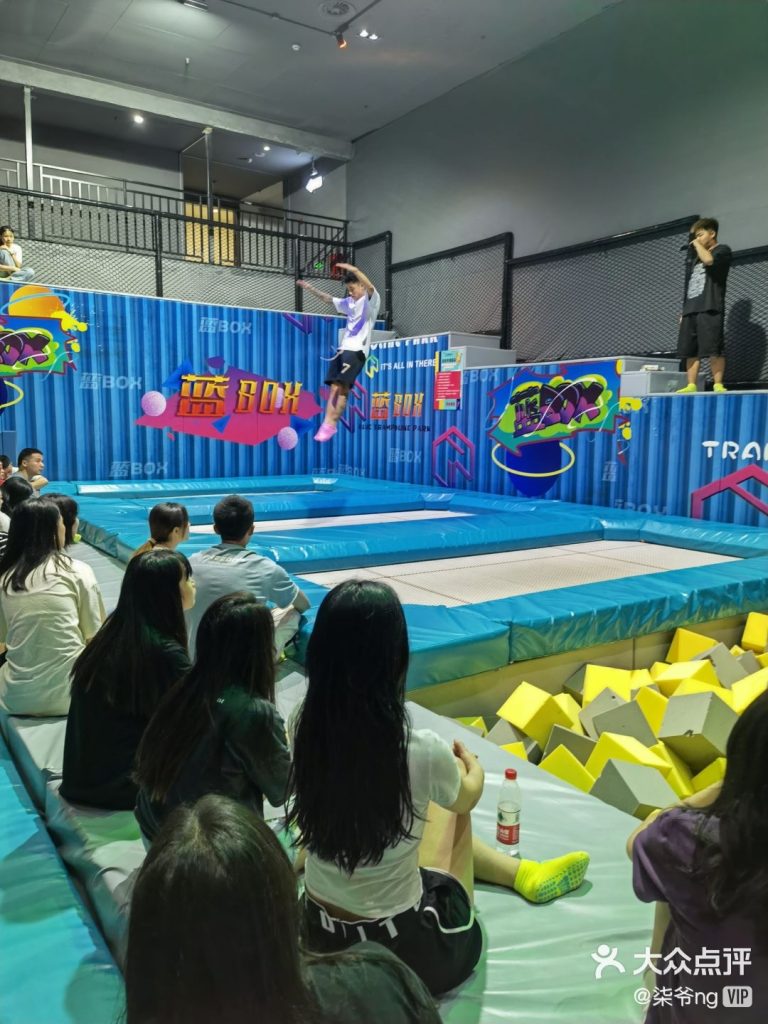
If you want to make a custom trampoline park, you need a good plan. The trampoline park business is growing fast. The market could be worth over USD 4.5 billion by 2033. Focus on safety, customer fun, and making money. When you plan the layout, pick fun attractions, and train your staff, your park can do well. Never skip safety or quality. If you want to start a trampoline park, remember that good planning helps you stand out. It helps you open a park that families enjoy.
- Market size in 2024: USD 1.19 billion
- Expected market size by 2033: USD 4.58 billion
- Growth rate: CAGR of about 16.2% (2025-2033)
Key Takeaways
- Begin with a clear idea for your trampoline park. Pick a special theme to bring in guests and help them remember their visit.
- Know who you want to come to your park. Aim for families and young people so your park fits what they want. This will help them want to return.
- Make safety the most important thing in your park. Use the right equipment and set easy-to-follow rules. Train your staff so everyone stays safe.
- Pick a good spot and enough space for your park. Find places where many people walk by. Make sure everyone can get to your park easily.
- Use smart ways to tell people about your park. Try social media, special events, and work with local schools to bring in more guests.
Set Your Vision
Define Your Custom Trampoline Park
When you plan a trampoline park, you need a clear idea. Think about what makes your park different from others. Decide how you want your park to look and feel. Many parks use themes to make the place more fun. You can choose a magical, sporty, or adventure theme. The right theme helps your park stand out. It also makes people want to visit again. Here are some popular theme ideas:
| Theme Type | Description |
|---|---|
| Immersive Themes | Use colors, art, and decorations to make a special place. |
| Legendary Stories | Create your park around a story or characters for a cool adventure. |
| Vibrant Designs | Use bright prints, bold colors, and fun features for more excitement. |
A good theme makes guests feel excited as soon as they enter.
Identify Target Audience
It is important to know who will visit your trampoline park. Most visitors are kids and teens, but adults and families like to jump too. Here is a quick look at who visits trampoline parks the most:
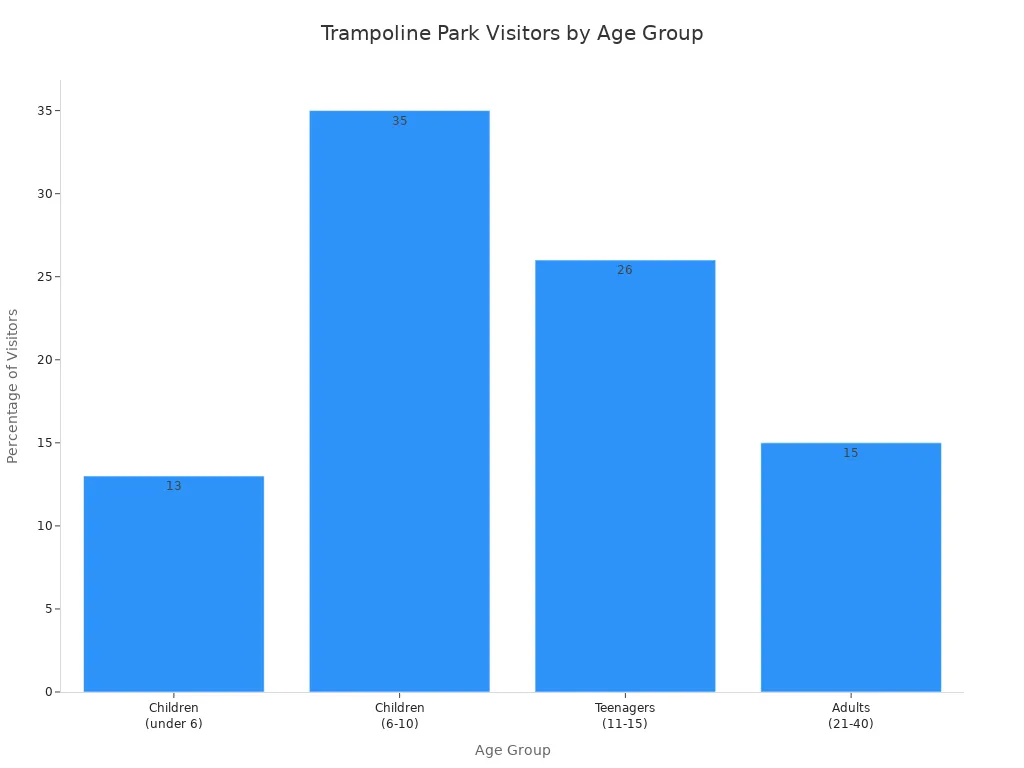
- Kids ages 6-10 are 35% of visitors.
- Teens ages 11-15 are 26%.
- Kids under 6 are 13%.
- In total, 77% of visitors are under 17.
- Adults ages 21-40 are 15%.
To make your trampoline park do well, focus on families and young people. Millennial parents want safe and active fun for their children.
Establish Business Goals
You need clear goals to help your trampoline park grow. Good goals keep your customers happy. Many owners want to:
- Make ticket and booking easy for everyone.
- Give deals and memberships to get more visitors.
- Add better food and drinks to earn more money.
You can also offer special memberships for your indoor trampoline park. For example, give all-access passes or discounts for first-time guests. When you set strong goals, you help your park do well and keep people coming back.
Market & Location
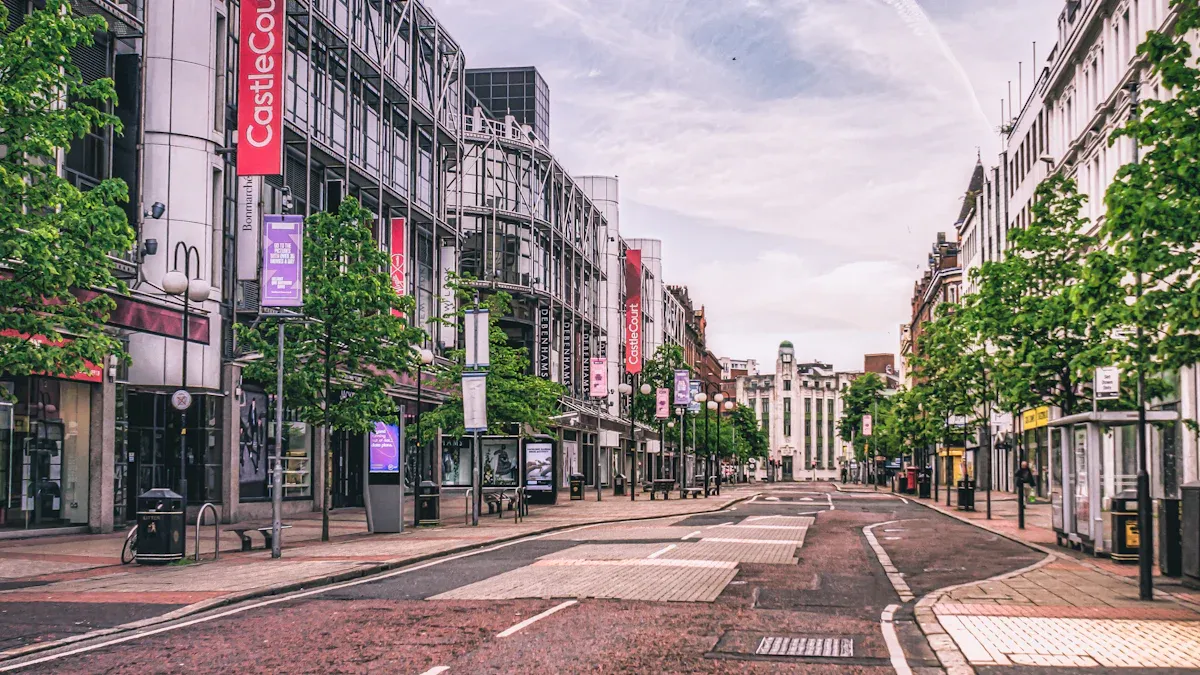
Research Local Demand
Before you open a trampoline park, you need to know if people in your area want one. Start by looking at other parks nearby. Check if families, schools, or sports teams visit them often. You can talk to parents, ask questions on social media, or even visit local events. If you see lots of kids and teens looking for fun, your trampoline park could do well in this location. Always look for places where families spend time together. This helps you find the ideal location for your business.
Choose the Right Space
You want your trampoline park to feel open and safe. When you choose the right space, look for a building with at least 1,500 square meters and a ceiling height of 7 meters. This gives you enough room for trampolines, foam pits, and other attractions. Rental costs can change a lot depending on the city. Here’s what you might pay for a commercial space:
- Average rental costs range from $2 to $8 per square foot.
Think about parking, nearby shops, and how easy it is for people to find your trampoline park. The ideal location should be close to schools, malls, or family neighborhoods. This makes it easy for guests to visit again and again.
Accessibility Factors
You want everyone to enjoy your trampoline park. Make sure your location meets all accessibility standards. This means you need ramps, wide doors, and clear signs. Here’s a quick look at some important rules:
| Section | Description |
|---|---|
| 15.1.2 | Alterations to Amusement Rides |
| 15.1.4 | Accessible Route |
| 15.1.5 | Load and Unload Areas |
| 15.1.6 | Signage |
| 15.1.7 | Amusement Rides With Wheelchair Spaces |
You must have at least one accessible entry point if your trampoline park has three or fewer entrances. If you have four or more, two must be accessible. At least half of your elevated play areas should be easy for everyone to reach. When you choose the right space, you make sure all guests feel welcome and safe.
Trampoline Park Design
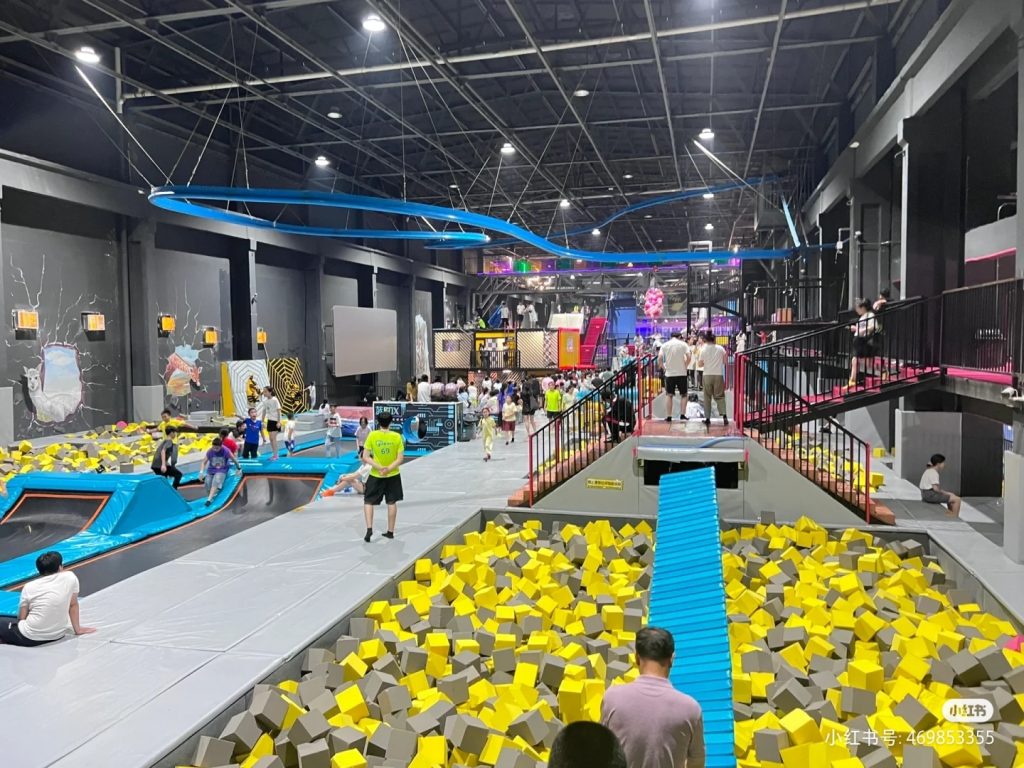
This is where your ideas become real. You want your trampoline park to feel safe and fun. It should also be easy for everyone to use. If you plan well, guests will have a great time and want to come back. Let’s look at the steps to make your trampoline park special.
Plan Layout
Start with the basics. You need enough room for everyone to jump and play safely. The International Association of Trampoline Parks says your building should be at least 1,672.3 m². The ceiling needs to be at least 5.3 meters high. Some areas, like foam pits or performance trampolines, need even more height. Here are the minimum heights you need:
| Specification Type | Minimum Height (m) |
|---|---|
| Standard Trampoline Park | 5.2 |
| High Performance Trampoline (13mm web mat) | 6.2 |
| High Performance Trampoline (6mm web mat) | 7.7 |
You can see how the ceiling height changes for each trampoline type:
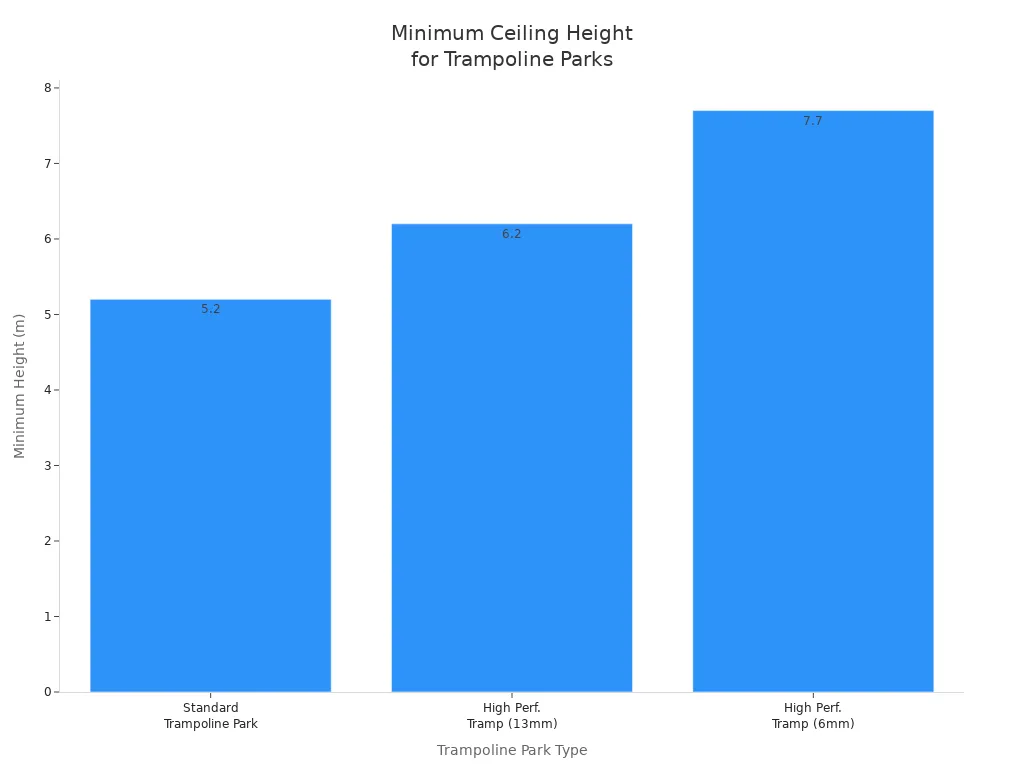
Safety comes first when you plan your layout. Use high side walls and spring covers to keep people safe. Set clear weight limits for each area. Make different spaces for different ages and skill levels. This helps everyone stay safe and have fun. Put up netting or barriers between sections to stop accidents. Make sure there are clear walkways for staff to watch guests and help if needed.
Tip: Always leave enough space above and around each trampoline. This helps stop injuries and makes your park feel bigger.
Select Attractions
Now you get to pick what goes inside your custom trampoline park. Today’s trampoline parks have more than just jumping. You can add attractions that match your theme and excite your guests. Here are some popular things you might want:
- Tumbling Lane for flips and tricks
- Performance Trampoline for high jumps
- Drop Slide with a soft landing
- Parkour Track for obstacle lovers
- Ninja Track for fitness and competition
- Air Bag for safe landings
- Air Track for gymnastic moves
- Challenge Track for speed runs
- Climbing Wall for all ages
- Dodgeball Area for team games
- Rotating Cylinder for balance challenges
Think about who will visit your park when you pick attractions. Kids like foam pits and dodgeball. Teens enjoy ninja tracks and parkour. Adults may want a climbing wall or a fitness area. A good mix of activities keeps everyone happy.
People now want more than just jumping. They like special events, cool themes, and even parks that care about the environment. Membership programs are also popular. These things help your indoor trampoline park stand out and make guests want to return.
Customer Flow
A smart design helps guests move around easily. You want everyone to find their way without getting lost or crowded. Divide your park into zones for different ages, activities, and skill levels. This keeps things safe and fun for everyone.
Here’s how you can set up your trampoline park for good customer flow:
| Element | Description |
|---|---|
| Distinct Zones | Separate spaces for different ages and activities. |
| Safety Features | Netting or barriers between sections to prevent accidents. |
| Entrance and Check-in Area | Large, welcoming area with clear signs and easy check-in. |
| Non-jump Areas | Party rooms, snack bars, and restrooms for breaks and events. |
| Staff Stations | Spots for staff to watch over guests and help quickly. |
| Safety Walkways | Clear paths for staff to move and monitor guests safely. |
Your entrance should feel open and friendly. Use signs to help guests find each area. Put party rooms and snack bars away from the main jumping zones. This keeps things quieter and gives families a place to relax. Staff stations should be close to all activity zones so help is always nearby.
Note: Good customer flow means fewer accidents and happier guests. It also makes work easier for your staff.
If you focus on safety, smart layout, and fun attractions, your trampoline park will be a hit. Planning takes time, but a great design brings happy guests and a strong business.
trampoline parks. Safety & Compliance
When you build a trampoline park, you must think about safety and compliance at every step. You want guests to have fun, but you also need to keep them safe and protect your business. Let’s look at what you need to know about safety features, permits, licenses, and the rules that help everyone stay safe.
trampoline parks. Safety Features
A trampoline park needs strong safety features. Injuries can happen quickly, so you must plan for every risk. Most accidents in trampoline parks are sprains, fractures, or falls. Kids often hurt their legs or elbows. The chart below shows how often these injuries happen:
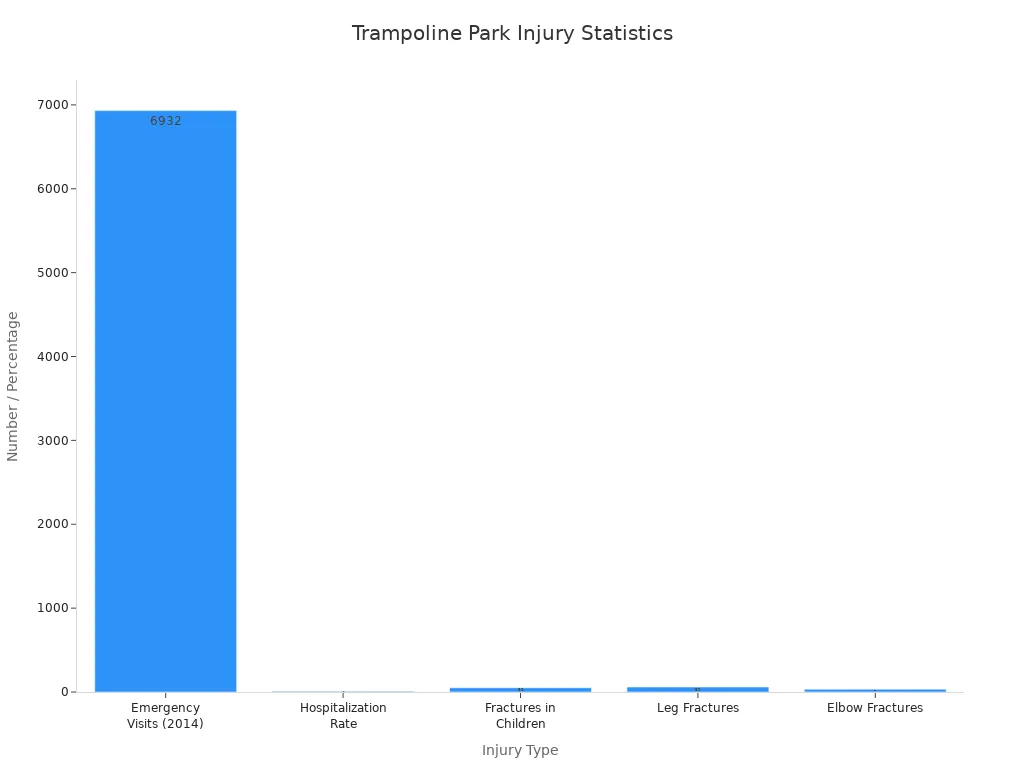
You can stop many injuries by using the right equipment and layout. Here’s a table with the most important safety features for your trampoline park:
| Feature | Description |
|---|---|
| Safety Pads | Made of high density, closed-cell foam that absorbs shocks and resists mildew. |
| Compliance | All pads exceed ASTM standards, ensuring safety and durability. |
| Design | Pads cover the trampoline frame and springs, with overlapping edges for added protection. |
| Attachment | Equipped with 8 to 24 straps to secure pads in place during use and high winds. |
You should also use high side walls, spring covers, and netting between zones. These features help stop falls and keep jumpers safe. Always separate areas for different ages and skill levels. Put staff stations near all activity zones so help is always close.
Tip: Only let one person jump on a trampoline at a time. This rule helps stop many injuries.
You also need insurance. Most places require trampoline park insurance. You need general liability, property insurance, and business interruption coverage. If you don’t have the right insurance, you could get fined or have to close your park.
Permits & Licenses
You must get all needed permits and licenses before opening your trampoline park. Every city and country has its own rules. You need to follow local regulations to stay open and avoid fines. Here’s a quick list of what you need to do:
- Make sure your trampoline park meets all safety standards through testing.
- Give technical documents and clear user instructions.
- Label all equipment with age limits, warnings, and traceability information.
You also need to know which standards apply in your area. Here’s a table to help you understand the main regulations:
| Region | Standards and Regulations |
|---|---|
| U.S. | ASTM International provides voluntary standards (ASTM F2970) for trampoline park operations. |
| Europe | EN 1176 and EN 1177 are the main standards for playground safety, with additional country-specific guidelines. |
| Germany | TUV certification is highly regarded for trampoline safety. |
You need permits for construction, fire safety, and health inspections. Some cities need special amusement licenses. You may also need to show proof of insurance before you get your permits. Always check with your local government to make sure you have every license you need.
Note: If you skip any permits or licenses, your park could get shut down. Stay organized and keep all your paperwork up to date.
Clothing & Weight Rules
You want everyone to be safe at your trampoline park. That means setting clear rules about what guests can wear and how much they can weigh. These rules help stop injuries and keep your insurance valid.
Here’s a table that shows what guests should and shouldn’t wear:
| Clothing/Accessory Type | Recommendation | Reason |
|---|---|---|
| Form-fitting Clothes | Yes | Prevents safety hazards from baggy clothing |
| Trampoline Socks | Yes | Provides traction and stability |
| Sweatpants/Yoga Pants | Yes | Offers protection from falls |
| Jewelry | No | Can cause injuries or get caught |
| Shorts | No | Lacks leg protection |
| Skirts | No | Self-explanatory safety concern |
Always ask guests to take off jewelry before jumping. Trampoline socks help stop slips and falls. Don’t allow shorts or skirts because they don’t protect the legs. Soft, form-fitting clothes are best.
You also need to set weight limits for each trampoline. Most parks set a maximum weight of 250 pounds per jumper. This keeps the equipment safe and lowers the risk of injury. Post these limits clearly in every jumping area.
Alert: If you don’t enforce clothing and weight rules, more people could get hurt and you might lose your insurance.
Train your staff to check clothing and enforce weight limits. Give guests lockers to store jewelry and loose items. This small step can make a big difference in safety.
By following all rules and focusing on safety, you protect your guests and your business. You need to follow all regulations, get the right permits, and enforce strict rules. When you do this, your trampoline park will be a safe and fun place for everyone.
Budget & Operations
Estimate Costs
You might ask, how much does it cost to start a trampoline park? The answer depends on your plan and what kind of park you want. If you pick a custom design, you get to choose every detail. But the price can be from $500,000 up to $3 million. Franchise parks like Sky Zone or Urban Air cost even more money. Here’s a quick look at the costs:
| Type of Trampoline Park | Investment Range |
|---|---|
| Custom | $500,000 to $3 million |
| Franchise (Sky Zone) | $2,330,960 to $5,175,460 |
| Franchise (Urban Air) | $3,111,409 to $8,382,109 |
Starting costs include equipment, the building, fixing up the space, permits, and technology. You will also pay for things like repairs, bills, advertising, staff, insurance, and supplies. Remember these costs so your trampoline park can make money and stay open.
Tip: Always save money for regular repairs. This keeps your trampoline equipment safe and helps your park stay open.
Equipment & Suppliers
Picking the right trampoline equipment is important for safety and fun. Good suppliers like Global Fun Sports use strong European materials and follow strict safety rules. Their products are checked by outside labs. Liben Group is another trusted supplier. They have certifications like ISO9001, EN/CE/ASTM, and more. Here are some top suppliers and their certifications:
| Supplier | Certifications |
|---|---|
| Liben Group | ISO9001, ISO14001, EN/CE/ASTM, EN ISO 23659:2022, EN 71 |
| Global Fun Sports | BSI PAS 5000, ASTM F2970-15, TÜV certified |
When you build your trampoline park, make sure all equipment meets standards like EN 71-14, EN 1176, EN 913, EN 13219, and REACH Regulation. This keeps your guests and your business safe.
Note: Check your trampolines often. Look for rips in mats, rusty springs, and loose padding. Fix problems right away to keep everyone safe.
Management Software
You need good software to help run your trampoline park. These tools help with booking, payments, and keeping guests safe. Look for features like:
- Slot-based booking for real-time updates
- POS software for fast payments
- Access control for easy guest entry
- Radian Glow wristbands for time tracking
- Party booking tools for group events
- Inventory management for supplies
- Waiver management for digital forms
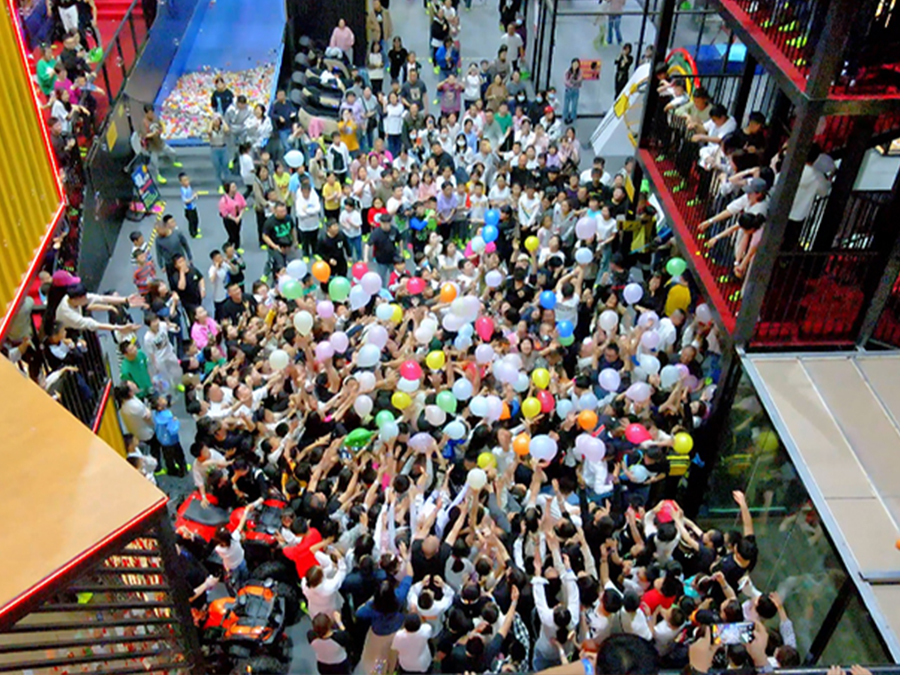
Booking engines, channel management, and CRM systems help you keep track of customers and events. These tools make your trampoline park easier to run and help you see how does a trampoline park make money. With the right software, you can focus on guest experience and making a profit.
Want to know how does a trampoline park make money? It’s about smart design, good equipment, and smooth operations. Watch your spending, and your trampoline park will do well.
Open & Manage
Installation
When you open a trampoline park, you want everything to go well. Setting up the park takes several steps. First, build the steel frames for each part. Use the technical drawings to help you. Start in one corner and move along the walls. Next, put in the passages and walls. Use plywood to make safe walkways after the metal frames are ready. Then, attach the springs and jump mats. Make sure the mats are tight and check for sharp things. After that, add soft pads and safety nets. Put pads around the jump mats and nets in open spaces to keep people safe. Last, add extra fun things to make your park special. Check every step closely. This helps you avoid problems and keeps everyone safe.
Staff Training
Your staff is very important when you open a trampoline park. Good training helps keep guests safe and happy. You want your team to know what to do all the time. Teach safety skills like first aid and emergency steps. Make sure everyone knows CPR and how to help if someone gets hurt. Train your team to talk to customers and solve problems. Good communication makes guests feel welcome. Go over safety rules often. Regular checks help your park run smoothly. A strong training plan helps you open your trampoline park with confidence.

Marketing & Growth
You need smart marketing to bring people to your trampoline park. Use different ways to reach families, schools, and groups. Here are some top ideas:
| Strategy | Description |
|---|---|
| Leverage Social Media Advertising | Share fun posts and ads on Facebook and Instagram to reach more people. |
| Host Themed Events | Plan glow nights or holiday parties to bring in new faces. |
| Offer Group Discounts | Give deals to schools and companies to fill your trampoline park. |
| Partner with Local Schools | Work with schools for student rewards and PE classes. |
| Create Engaging Content | Post videos and blogs to show off your trampoline park and connect with the community. |
You can also give weekday deals and birthday party packages. Retargeting ads help you reach people who already looked at your park. Make booking easy so customers can reserve spots fast. When booking is simple, people want to come back. If you have problems like higher costs or tough competition, try new attractions and use your space well. Keep your marketing fresh to bring in more guests and help your business grow.
You now know how to make a custom trampoline park. Always put safety first and plan carefully. Give your guests a fun experience every time. If you ask, “How much does it cost to start a trampoline park?” the answer depends on your choices. The rewards can be great if you plan well. Experts say you should check your market and look at your competition. Build a strong business plan before you start. Many owners see lots of visitors and steady profits.
| Benefit | Description |
|---|---|
| High turnover | Different programs bring in more people |
| Profit potential | Charging visitors and renting space makes money |
Start your journey now. Get help from experts if you need it. A good trampoline park gives families fun, keeps everyone safe, and helps your business grow.
FAQ
How long does it take to build a trampoline park?
Most parks take about 3 to 6 months to build. The time depends on your location, permits, and how complex your design is. Planning ahead helps you open faster.
What insurance do I need for my trampoline park?
You need general liability insurance. Some places also ask for property and accident coverage. Talk to an insurance expert to make sure you have the right protection.
Can adults use the trampolines too?
Yes! Many adults love jumping. Just follow the posted rules and weight limits. Some parks even offer fitness classes or special adult nights.
How do I keep my trampoline park clean?
You should clean mats, pads, and common areas every day. Use safe cleaning products. Staff should check for spills or trash often. Clean parks keep guests happy and safe.
What makes a trampoline park successful?
Great customer service, fun attractions, and strong safety rules help your park stand out. If you listen to your guests and keep things fresh, people will want to come back.
